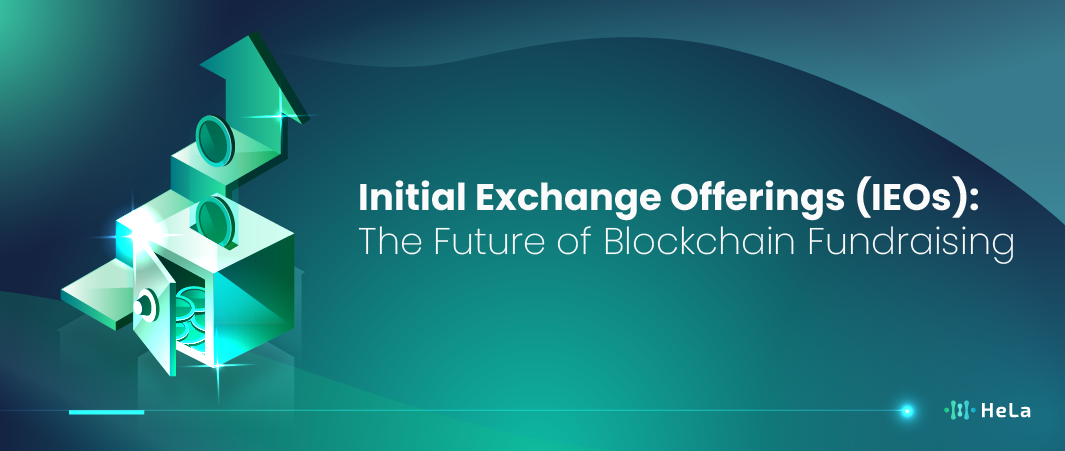The cryptocurrency world has evolved significantly over the past decade, with various methods emerging for blockchain projects to raise funds. Among these, Initial Exchange Offerings (IEOs) have become a popular fundraising model, providing a structured and secure way for blockchain startups to attract investors. By leveraging the reputation of established cryptocurrency exchanges, IEOs have created an environment where both projects and investors can feel more confident about the legitimacy of the token sale.
IEOs offer an alternative to the traditional Initial Coin Offerings (ICOs), which were marred by numerous scams and regulatory challenges. With exchanges acting as intermediaries, IEOs ensure that projects are properly vetted and investors are protected, thus offering a more reliable fundraising approach. This article will explore what an IEO is, its advantages and disadvantages, and how it compares to other fundraising models like ICOs and Security Token Offerings (STOs).
What Is An Initial Exchange Offering (IEO)?

Initial Exchange Offerings, or IEOs, represent a form of crowdfunding conducted directly through a cryptocurrency exchange. They have gained popularity in recent years due to their ability to streamline the fundraising process for blockchain projects while providing an added layer of security and convenience for both investors and startups. Unlike Initial Coin Offerings (ICOs), which often left investors vulnerable to scams and regulatory issues, IEOs leverage the credibility of established exchanges, offering a more secure and trusted environment for fundraising.
IEOs have emerged as an attractive option in the world of cryptocurrency because they combine the benefits of a broad audience reach with the security measures enforced by exchanges. In this article, we will delve into the fundamentals of IEOs, examine their benefits and potential drawbacks, compare them with other methods like ICOs, and explore their impact on the crypto landscape.
Read More: 10 Best Web 3.0 Coins to Consider in 2024
The Concept of IEO
An Initial Exchange Offering (IEO) is a type of token sale managed by a cryptocurrency exchange. Unlike ICOs, where the project team themselves handle the token sale, an IEO is conducted on a digital asset exchange platform, which provides trust and security assurances to investors. Typically, the exchange facilitates the sale, promotes the project, and manages all transactions, allowing for a more streamlined and trustworthy experience.
The main distinction between an IEO and other fundraising models is that exchanges serve as intermediaries, providing credibility and reducing the risk of scams. IEOs have grown in popularity as they offer startups instant exposure to an exchange’s user base, potentially making fundraising more efficient.
How Do IEOs Work?

To participate in an IEO, a blockchain project must partner with a cryptocurrency exchange. The exchange then reviews the project’s technical capabilities, tokenomics, and team to ensure quality and legitimacy. Once approved, the token sale is hosted on the exchange’s platform.
Investors need to create an account on the participating exchange and pass through any verification requirements before participating in the IEO. The exchange manages the token sale, facilitating the buying process by accepting payments in the form of well-known cryptocurrencies such as Bitcoin (BTC) or Ethereum (ETH). Once the token sale is complete, the new tokens are automatically distributed to investors’ accounts.
Benefits of Initial Exchange Offerings

Initial Exchange Offerings provide several key benefits that make them an attractive option for both blockchain projects and investors. By leveraging the credibility of established exchanges, IEOs ensure that the fundraising process is more secure, efficient, and accessible, compared to other token sale models like ICOs. Below, we outline the major benefits of IEOs that have contributed to their growing popularity.
1. Security and Trust
Since IEOs are managed by established exchanges, they benefit from the exchange’s reputation and security measures. Exchanges conduct due diligence on the project, reducing the chances of fraud. This vetting process ensures that only credible projects are launched, adding a layer of security that instills confidence in potential investors. The due diligence conducted by exchanges helps weed out low-quality or potentially fraudulent projects, significantly reducing the risks associated with token sales.
Additionally, exchanges utilize advanced security protocols to protect both the project and investor funds. By acting as a trusted intermediary, the exchange provides a safer environment for conducting token sales compared to traditional ICOs. This reputation for security makes IEOs particularly appealing to investors who are wary of the risks of participating in blockchain fundraising initiatives.
2. Streamlined Process
The token sale process is handled by the exchange, reducing the workload on the project team. This simplifies the technical aspects of fundraising and allows the team to focus on development. Instead of managing the complexities of building a token sale infrastructure, projects can rely on the exchange to manage everything from marketing to transaction handling, significantly reducing operational burdens.
With the exchange managing the logistics of the sale, project teams can devote more time to refining their product, expanding their technology, and preparing for launch. This delegation of responsibilities not only streamlines the fundraising process but also contributes to the overall quality and success of the project post-IEO. It provides a smoother experience for investors, who can participate without worrying about the reliability of the project’s token sale platform.
3. Exchange-Ready
After an IEO, tokens are often listed immediately on the exchange, providing instant liquidity for investors. This offers a significant advantage over ICOs, where listing on an exchange can be a prolonged and uncertain process. Investors can start trading the newly acquired tokens right away, which helps maintain momentum and build confidence in the project.
Instant liquidity is a major selling point for IEOs, as investors no longer have to wait weeks or months for a token listing. This quick turnaround not only provides an incentive for more people to participate in the IEO but also ensures that tokens can begin circulating in the market, adding to their utility and perceived value. For the project, immediate listing helps establish a market presence and creates a positive first impression in the community.
4. Wider Reach
By leveraging an exchange’s existing user base, blockchain projects gain access to a large pool of potential investors who are already comfortable trading cryptocurrencies. This wide reach is particularly advantageous for projects that might otherwise struggle to gain traction and visibility in the crowded crypto landscape.
Exchanges invest in promoting their IEOs to their user base, which means projects benefit from ready-made marketing campaigns and a targeted audience of investors. This can lead to higher participation rates and a more successful token sale, as the project does not need to spend excessive resources building a community from scratch. For investors, the convenience of purchasing tokens through a familiar platform makes the process smoother and more appealing, further increasing participation rates.
Risks Associated with IEOs

While IEOs have notable benefits, they are not without their risks. Here are a few aspects investors and project developers should consider:
- Centralization: IEOs rely heavily on the centralized infrastructure of an exchange. This centralization creates a single point of failure, and investors are dependent on the security practices of the exchange.
- Regulatory Scrutiny: Exchanges need to comply with regulations, which may vary significantly across different jurisdictions. Projects that choose to launch an IEO may face regulatory restrictions, and in some cases, participation may be restricted to certain geographic regions.
- High Costs: Exchanges often charge significant fees to facilitate an IEO, including listing and marketing costs. These costs can be a burden for small projects, making IEOs more suitable for well-funded startups.
- Limited Investor Access: Many exchanges require investors to complete KYC (Know Your Customer) processes before participating in an IEO. While this adds security, it also limits accessibility, particularly for individuals in regions where regulatory frameworks are still developing.
IEO vs. ICO vs. STO
To better understand the uniqueness of IEOs, it is helpful to compare them with other popular fundraising models: Initial Coin Offerings (ICOs) and Security Token Offerings (STOs).
Feature | ICO | IEO | STO |
Platform | Conducted by the project | Conducted by an exchange | Conducted by compliant broker |
Security | High risk of scams | More secure (exchange-backed) | Subject to securities laws |
Participation | Open to anyone | Limited to exchange users | Restricted to accredited investors |
Regulation | Often unregulated | Exchange-dependent | Highly regulated |
Graph: Growth in Popularity of IEOs
The graph below shows the rise in IEO popularity from 2019 to the present, emphasizing how this fundraising model has transformed over time in comparison to ICOs and STOs.
How to Participate in an IEO
If you are interested in participating in an IEO, the steps below provide a general overview of how to get started:
- Choose a Reliable Exchange: Ensure you are using a reputable cryptocurrency exchange. Exchanges like Binance, Huobi, and KuCoin have a good track record for conducting IEOs.
- Create and Verify Your Account: Create an account on the chosen exchange. Complete the KYC process, which may include identity verification steps, to ensure compliance with local regulations.
- Fund Your Account: Most IEOs require investors to purchase tokens using well-known cryptocurrencies like Bitcoin or Ethereum. Fund your account accordingly.
- Follow the Exchange Announcements: Exchanges typically announce upcoming IEOs and provide specific details, such as token price, sale dates, and other requirements. Make sure you keep up with these announcements to avoid missing any deadlines.
- Participate in the Sale: Once the IEO is live, you can participate by using the exchange’s IEO platform. Ensure you follow all instructions carefully to successfully purchase the tokens.
Notable IEOs
Several projects have used the IEO model to successfully raise funds. Some of the most notable examples include:
- BitTorrent (BTT): BitTorrent was among the first high-profile projects to raise funds through an IEO on Binance. The sale was highly successful, selling out in minutes.
- Matic Network (now Polygon): The Matic Network, now known as Polygon, also conducted an IEO on Binance, gaining immense traction. It has since become one of the leading Layer 2 solutions in the crypto space.
- Elrond (EGLD): Elrond’s IEO on Binance raised significant funds and has since grown into a prominent blockchain platform that focuses on high scalability, fast transaction speeds, and lower costs.
Pros and Cons of IEOs
Initial Exchange Offerings (IEOs) come with a unique set of advantages and disadvantages that make them suitable for some projects while less ideal for others. Below, we delve into the pros and cons of IEOs to help you better understand their potential impact on both investors and project teams.
Pros:
- Enhanced Trust: Projects that conduct IEOs are vetted by exchanges, which helps reduce fraud and increase investor confidence.
- Exchange Listing: Tokens are generally listed on the exchange soon after the sale, providing immediate liquidity.
- Access to Existing User Base: Projects can reach out to a large, existing user base without having to build their own marketing campaigns from scratch.
Cons:
- Centralization: By relying on centralized exchanges, the core value of decentralization is undermined.
- High Cost for Project Teams: Exchange fees can be expensive, which may exclude smaller or less well-funded projects.
- Investor Limitations: Requirements such as KYC can limit participation, particularly in regions without regulatory frameworks for cryptocurrencies.
The Future of IEOs
The future of Initial Exchange Offerings will depend largely on regulatory developments and the evolution of the cryptocurrency market as a whole. As regulatory oversight increases globally, exchanges will have to implement stricter KYC and Anti-Money Laundering (AML) procedures, which could influence the accessibility of IEOs. Nevertheless, the credibility brought by exchanges and the relatively straightforward process make IEOs an attractive choice for many blockchain startups.
Read More: 10 Best Crypto Signals That Prepare You For Next Bull Market
IEOs have also paved the way for the emergence of newer fundraising models like Initial Dex Offerings (IDOs), where decentralized exchanges (DEXs) are used to facilitate token sales. IDOs offer a more decentralized fundraising approach and lower fees, but with less regulatory oversight compared to IEOs.
Conclusion
Initial Exchange Offerings (IEOs) have become an important innovation in the blockchain fundraising ecosystem. By utilizing the credibility and reach of well-known exchanges, IEOs help reduce the risk of scams and make the fundraising process more efficient for blockchain startups. They offer significant advantages in terms of security, streamlined processes, and instant liquidity, making them appealing to both developers and investors.
However, with the rise in regulatory scrutiny and the emergence of newer, decentralized fundraising methods like IDOs, the popularity of IEOs may face challenges. As the landscape continues to evolve, one thing is clear: the crypto industry will keep innovating in its quest to create more secure, accessible, and efficient fundraising mechanisms.
For those considering participating in or launching an IEO, understanding both the advantages and potential pitfalls is crucial. It’s not just about raising funds; it’s about doing so in a secure, efficient, and sustainable manner. As exchanges continue to offer IEOs, they have the power to help transform the blockchain space by bringing promising projects into the limelight.
Disclaimer: The information provided by HeLa Labs in this article is intended for general informational purposes and does not reflect the company’s opinion. It is not intended as investment advice or recommendations. Readers are strongly advised to conduct their own thorough research and consult with a qualified financial advisor before making any financial decisions.

I am Carina Caringal, a technical writer specializing in blockchain engineering concepts, decentralized systems, crypto infrastructure, and Web3 technologies. My work focuses on analyzing and translating complex technical mechanisms into precise, structured, and insightful content for both developers and non-technical readers who want a deeper understanding of the decentralized ecosystem.
My background in blockchain and cryptocurrency is rooted in years of independent research, continuous learning, and hands-on exploration across multiple protocols and network architectures. I study the underlying mechanics of distributed ledger technology, from consensus algorithms and smart contract logic to network scalability, security models, cryptographic principles, and interoperability frameworks. This technical foundation shapes the way I approach every article, ensuring accuracy, depth, and relevance.
- Carina Caringalhttps://helalabs.com/blog/author/carina-caringal/
- Carina Caringalhttps://helalabs.com/blog/author/carina-caringal/
- Carina Caringalhttps://helalabs.com/blog/author/carina-caringal/
- Carina Caringalhttps://helalabs.com/blog/author/carina-caringal/

